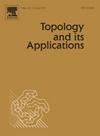在p > 处限定K(p − 1)-本地奇异皮卡德群3
IF 0.5
4区 数学
Q3 MATHEMATICS
引用次数: 0
摘要
本文对素数p>;3和n=p−1的奇异Picard群κn的下降滤波进行了定界。我们的方法详细比较了Picard谱序列、同伦不动点谱序列和辅助β-倒同伦不动点谱序列,其输入是Morava稳定群的Farrell-Tate上同调。在此过程中,我们推断出球的K(n)局部Adams-Novikov谱序列在E2n2+2页上的3n2+1处有一条水平消失线。同样的分析也允许我们表示同伦不动点谱EnhN上的K(n)个局部模的奇异Picard群,其中n是p阶的有限循环子群在Gn中的正则化项,作为单个连续上同调群H2n+1(n,π2nEn)的子商。本文章由计算机程序翻译,如有差异,请以英文原文为准。
Bounding the K(p − 1)-local exotic Picard group at p > 3
In this paper, we bound the descent filtration of the exotic Picard group , for a prime number and . Our method involves a detailed comparison of the Picard spectral sequence, the homotopy fixed point spectral sequence, and an auxiliary β-inverted homotopy fixed point spectral sequence whose input is the Farrell-Tate cohomology of the Morava stabilizer group. Along the way, we deduce that the -local Adams-Novikov spectral sequence for the sphere has a horizontal vanishing line at on the -page.
The same analysis also allows us to express the exotic Picard group of -local modules over the homotopy fixed points spectrum , where N is the normalizer in of a finite cyclic subgroup of order p, as a subquotient of a single continuous cohomology group .
求助全文
通过发布文献求助,成功后即可免费获取论文全文。
去求助
来源期刊
CiteScore
1.20
自引率
33.30%
发文量
251
审稿时长
6 months
期刊介绍:
Topology and its Applications is primarily concerned with publishing original research papers of moderate length. However, a limited number of carefully selected survey or expository papers are also included. The mathematical focus of the journal is that suggested by the title: Research in Topology. It is felt that it is inadvisable to attempt a definitive description of topology as understood for this journal. Certainly the subject includes the algebraic, general, geometric, and set-theoretic facets of topology as well as areas of interactions between topology and other mathematical disciplines, e.g. topological algebra, topological dynamics, functional analysis, category theory. Since the roles of various aspects of topology continue to change, the non-specific delineation of topics serves to reflect the current state of research in topology.
At regular intervals, the journal publishes a section entitled Open Problems in Topology, edited by J. van Mill and G.M. Reed. This is a status report on the 1100 problems listed in the book of the same name published by North-Holland in 1990, edited by van Mill and Reed.

 求助内容:
求助内容: 应助结果提醒方式:
应助结果提醒方式:


